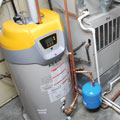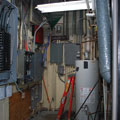
Frito pie is one of the signature dishes you’ll find attayst Restaurant & Wine Barlocated in the Hillsboro Village section of Nashville, Tenn.
But this isn’t your mom’s Frito pie from childhood days. Owner and ChefJeremy Barlowhas incorporated the restaurant’s “playful American” culinary style to this longtime staple. The Fritos are made of polenta (a thick cornmeal mush) and Barlow uses duck legs and duck fat to create duck confit, which is then used in the chili portion of the entrée. A duck breast applied to the top of the pie finishes things off.
“Our food is based on Southern traditions, but we make them kind of funky at the same time,” Barlow says. “We’ll twist and tweak them. We try to elevate the dishes and make them fancy and fun.”
More importantly for Barlow, all the ingredients in the dish are sustainable. The polenta, for example, is from a local organic mill. Barlow’s commitment to sustainable ingredients in his dishes is part of an overall green footprint he has embraced for his restaurant - an initiative that has led to tayst (named after the phonetic spelling of “taste”) being Nashville’s first and only Green Restaurant Association-certified establishment.
“Food-wise, you basically want to get as much local as possible,” Barlow says. “We try to only source from farms that are sustainable. The farm can’t only be local. It has to be local and it has to be certified organic. You need to have a relationship with the farmer to know how he farms and make sure he isn’t using pesticides and fertilizers and that he’s not destroying the land while he farms on it.”
The fare, however, is far from the only sustainable element in the restaurant. Beeswax candles in the dining room, high-efficient lighting throughout the facility and low-flow faucet aerators and restroom dual-flush valves (by MJSI) have contributed to energy and water conservation, as has another key energy-saving upgrade - the installation of two high-efficiency commercial gas water heaters.
“The restaurant industry is the largest consumer of energy and generator of waste in our country,” Barlow states. “We can make a difference by trying to conserve.”

Water, Water, Water
In any restaurant, water - and particularly hot water - is constantly in demand, a fact Barlow knows all too well.“In a restaurant, water-heater usage is pretty significant,” he says.
Barlow originally had two 80% efficiency residential water heaters running out of his mechanical room.
“The water heaters weren’t that old,” he notes. “They were five years old, but they were constantly going. You’d go in and out of that room and you’d see the flame constantly on.”
In addition to a constant gas and energy drain, the layout of the restaurant provided an additional headache in terms of hot-water efficiency.
“We have a long building here,” Barlow explains. “Where the bar is located and in the back part of the building, it was sometimes hard to get hot water to those locations. The hot water here was not that great.”
Chance Meeting
David Chisholm, brand manager at Lebanon, Tenn.-based water-heater manufacturer A.O. Smith, says his company already had the Green Restaurant Association and its certification program on its radar when an A.O. Smith employee happened upon Barlow’s eatery.“Somebody saw the restaurant and saw the Green Restaurant Association logo on the front door and started asking questions,” Chisholm says.
Barlow ended up having two A.O. Smith Cyclone Xi commercial gas water heaters (96% thermal efficiency and inputs up to 500,000 Btu) installed.
“The food thing is what started the green certification push,” Barlow says. “We were so far in that direction already, but we realized that if we’re taking care of the back of the house (kitchen), we should also care about the front of the house. We wanted to further our environmental efforts with things like energy and water conservation.”

Limited Installation Headaches
Frank Sullivan, of Joe B. Sullivan and Son in Nashville, handled the removal of the old residential water heaters and the installation of the new high-efficiency models. One of the few problems Sullivan encountered was a space constraint in the mechanical room.“There was a very, very minimal amount of space,” he notes. “That’s the trend with restaurants. There is less and less space in mechanical rooms almost out of necessity in order to put more people at tables. Water heaters usually take the brunt of it.”
Sullivan, whose company dates back to 1895 and has featured four generations of Sullivans, says a favorable venting setup with the condensing water heaters greatly helped with installation in such a confined space.
“The units are direct-vented so you don’t have makeup air coming from the building,” he says. “That helped us to tighten up on everything more than we normally would (in terms of installation). Because the water heaters have sealed combustion, direct venting is the key. We brought pipe from the outside into the water heaters themselves.”
Being direct-vented, the units’ functionality is not dependent upon other atmospheric factors in the restaurant.
“We’re not pulling any air out of the building. No matter what any other piece of equipment is doing in the building, you will have the right amount of combustion air for the heaters,” Sullivan says. “That allows for proper operation. The capability of direct venting made it an easier installation; we didn’t have to worry about negative pressure affecting the water heaters themselves.”
Sullivan was able to concentric-vent one of the new water heaters through the existing roof penetration (used for one of the old models) and was fortunate to find an additional dormant penetration to vent the other water heater.
“Usually you have just one penetration,” he explains. “In this case, there was one sitting there that was not being used. When you are dealing with penetrations, one of the tougher things is getting out of the building and getting the air in and the exhaust out and making sure no water gets around the perimeter.”
Sullivan emphasizes the units’ sealed combustion provides an added safety benefit in a bustling commercial setting.
“Most restaurants are very cramped for storage. You’ll find paper, plastic and chairs stacked in front of the water heater,” he says. “Because it’s sealed combustion, it eliminates the open flame. You can put those water heaters in a storage room and not have to worry about the building burning down.”

Benefits and Savings
Barlow is thankful the water heater switch did not cause the restaurant to close for any length of time. He says the removal and installation process was done in a day.“We’re a small place,” he says. “We didn’t have the money to stop what we were doing and close and put in a complete overhaul. We’re chipping away at all of the things we can do to increase our green certification.”
The installation of the high-efficiency models has aided in that chipping-away process.
“It’s really helped energy-wise,” says Barlow, who estimates the restaurant goes through 24,000 gallons of water a month (Barlow adds the restaurant has saved 14,000 gallons a month by installing low-flow aerators on the faucets). “In combination with the light bulbs, we’ve cut our energy usage 20%. I looked at solar water heating at about the same time, but I wasn’t sure if it could stand up to a commercial application in a restaurant. It’s amazing what the water heaters have done. You turn them on and they are hot in two minutes. It’s like night and day.”
Sullivan helped Barlow with some green savings in the billfold by being forced to install PVC pipe as opposed to steel double-wall venting pipe.
“You can’t use steel pipe because those water heaters are condensing,” Sullivan states. “The only approved medium is to go through plastic because it’s a positive pressure vent. There is very little heat leaving that water even at upper temperatures. You can’t feel any residual heat.”
And as Sullivan explains, that lack of escaping heat from the units, which employ helical coil heat exchangers, is where gas and energy efficiencies take center stage.
“You’re trapping and retaining the heat,” he says. “With a conventional gas water heater at your house, you wouldn’t want to put your hand on the pipe. With these high-efficiency units, you could put your face up against it. That’s how much heat is being retained in the water and that’s how you get your fuel efficiency. You’re keeping the exhaust flue temperature down.”
Fears of any malfunctions with the water heaters have been assuaged thanks to modern technology. Barlow is able to remotely monitor the water heaters’ energy consumption and troubleshoot potential problems thanks to a compatible Icomm electronic interface.
“You can watch things wirelessly and they’ll send you a text message if something is wrong,” he says. “That’s important. This is my business. If the water heater goes out, I’m out of business until it’s fixed.”
Barlow actually did get a text message about one of the heaters possibly malfunctioning.
“A chair got too close and the server got pinched. The system is great except when you get a 4 a.m. call,” he laughs.
Barlow even has named the water heaters after a droid character in the “Star Wars” movies.
“They are my R2-D2s,” he says. “What guy growing up in my generation doesn’t want an R2-D2 of his own?”
For Barlow, those R2-D2s have helped with his long-term green vision.
“Every chef looks for the best food,” he says. “That leads you to buying local food, which leads you to buying sustainable food, and one thing leads to another and you get wrapped up in it. Everything you do you try and tweak and make better so you can make less of an (environmental) impact. We’re working on getting rid of our carbon footprint. We’re climbing the green ladder.”
And tayst is quickly nearing the top rung.

